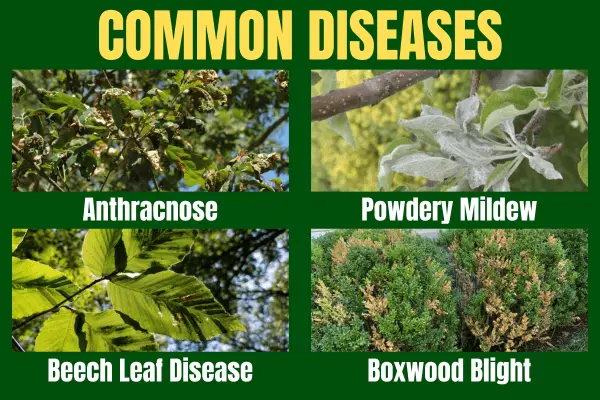Spotted Lanternfly Management
The Spotted Lanternfly is an invasive, destructive pest that was discovered in the United States in 2014. Populations of Spotted Lanternflies have been confirmed in Bucks, Montgomery, Chester, and Lehigh counties, and have been spreading across the region. Cases increased by 500% in our region compared to last year.
PROPERLY TIMED, EFFECTIVE TREATMENTS
Spotted Lanternflies feed on a variety of trees and plants, particularly the Tree of Heaven, Ailanthus Altissima. Our Certified Arborists may recommend:
Removing the host tree to prevent attracting Spotted Lanternflies.
Identifying which valuable, high-risk trees should be protected.
Removing egg masses to prevent new Spotted Lanternflies from hatching.
If you see signs of a spotted lanternfly infestion in any stage of their life cycle, contact us at 215 - 428 - 1323
Spotted Lanternfly Life Cycle
Spotted Lanternflies have several stages in their life cycle, including the egg laying stage, which occurs from September through late November or early December. Any observed egg masses should be scraped off to prevent them from hatching in the Spring. After hatching, there are three Spotted Lanternfly nymph stages in which their appearance changes from a black color with white spots, to a mixture of red and black with white spots. Following the third Spotted Lanternfly nymph stage, the adult Spotted Lanternflies emerge in July.
If you see signs of a spotted lanternfly infestion in any stage of their life cycle, contact us at 215 - 428 - 1323
Spotted Lanternfly FAQs
A: Spotted Lanternflies are pretty distinct. Named for the spots on the wings during the adult stage and the spots on the back during the nymph stage, this is the easiest way to distinguish spotted lanternflies. They are typically about an inch long, and an inch and a half wide. During the egg laying stage, spotted lanternflies create masses of eggs that resemble clay-like substances. Older masses tend to break apart and crack.
A: Unfortunately, spotted lanternflies are not native to the United States, and are therefore invasive. Originally from China, Spotted Lanternflies are plant-hopping species that first appeared in the United States in 2014. Since then, it has evolved to officially be classified as an invasive species that can be found all through the Northeastern Corridor of the United States, including Bucks County, Pennsylvania.
A: Spotted Lanternflies in the nymph stage will begin to emerge from their egg masses in the beginning of April.
A: Spotted lanternflies are attracted to the tree of heaven, otherwise known as Ailanthus altissima. Spotted lanternflies seek out the tree of heaven because it is their preferred place to lay their eggs. However, there are other plant hosts that spotted lanternfly’s are attracted to in Pennsylvania. A few of these include grape, river birch, sumac, rose, silver and red maple, black and butternut walnut, as well as willow.
A: Spotted Lanternflies aren’t directly dangerous to humans, but are a danger to crops and trees. Because they are non-native to our area, they do not have any natural predators, which means their population can and will go unchecked. When there are too many specimen feeding on the sap of tree branches and trunks, substantial damage can occur. Indirect damage also can occur due to the formation of honeydew, the lanternflies’ secretions, which then attracts other insects. Those insects facilitate the growth of mold on the sap, severely limiting the plant’s ability to photosynthesize, potentially resulting in death.
A: If your infestation is severe, the best approach to eliminating them is to call an expert. Shades of Green, Inc. proudly serves the Bucks County area, and offers free estimates on spotted lanternfly removal. Our properly timed, effective treatment has proven to eliminate spotted lanternflies in the Pennsylvania area. Contact us today for your free estimate.
A: The Spotted Lanternfly was first discovered in Berks County in 2014.
A: The PA Department of Agriculture has been monitoring the lanternfly since their first appearance in 2014. They have set up a plan to contain and destroy them using a quarantine zone with the DOT monitoring truck drivers to ensure they are following proper quarantine procedures.
A: The Spotted Lanternfly is attracted to and feeds on a variety of trees and plants, but adults prefer the Ailanthus Altissima, or the Tree of Heaven. They use this tree as a place to lay their eggs. This is due to the Tree of Heaven also being an invasive species from China. We recommend contacting our professional arborists at Shades of Green, Inc. for your one-stop-shop removal of both invasive species.
A: No, lanternflies will not bite a human.
A: They feed on the sap from trees and plants.
A: Spotted lanternflies are actually easiest to see at dusk/night, because this is when they gather in large clusters on trees and plants and migrate up and down.
A: After feeding on a host, the spotted lanternfly excretes honeydew from the nutrients in the sap. This honeydew promotes the growth of harmful mold, which can ultimately harm your trees and plants. Because this can end up fatal to the trees, it is recommended to have professionals assess your trees and any damage. Shades of Green, Inc. offers free consultations.

